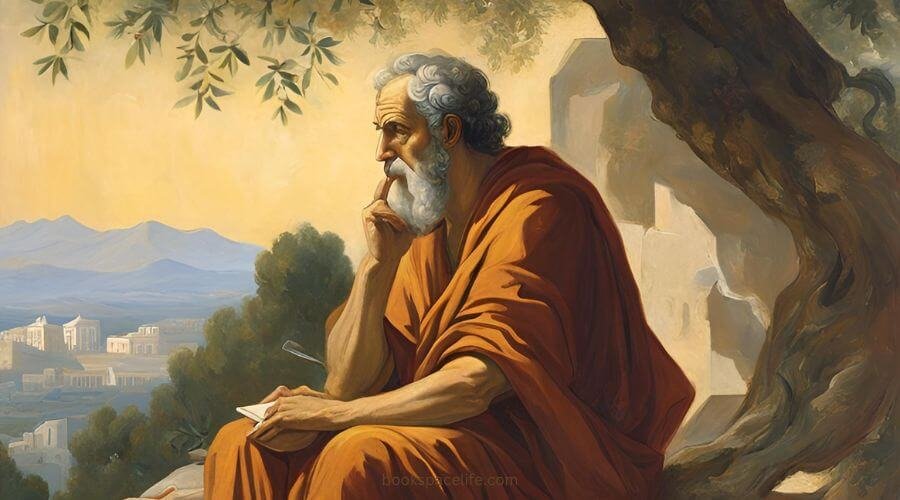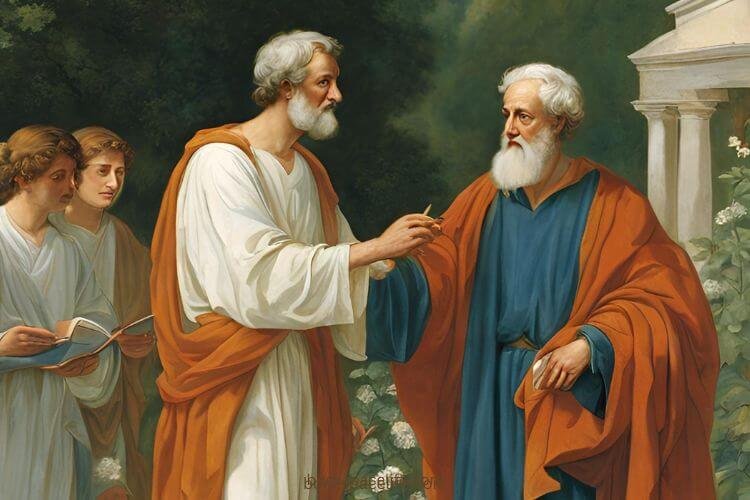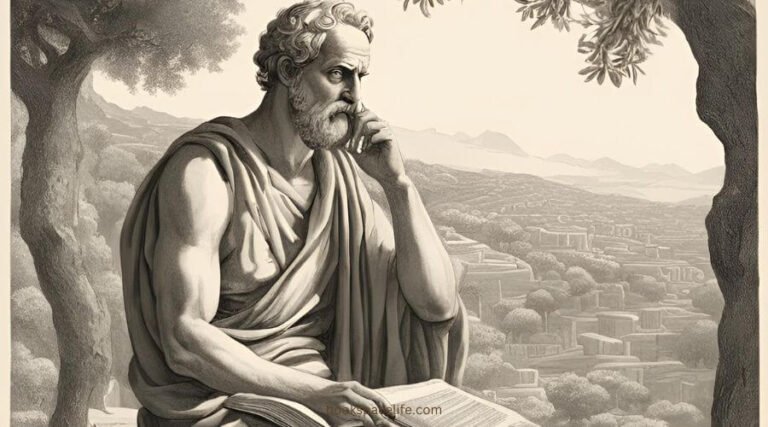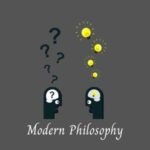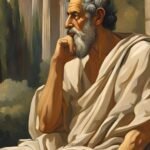Thales of Miletus
Zeno of Elea : The Paradoxical Thinker of Ancient Greece
Zeno of Elea (490 – 430 BCE) is one of the most influential philosophers in the history of Western thought.
Born in the ancient Greek city of Elea, Zeno is best known for his paradoxes, which challenge our understanding of motion, time, and space.
As a student of the philosopher Parmenides, Zeno sought to defend and elaborate on his teacher’s ideas regarding the nature of reality and the limits of human perception.
This blog post will explore Zeno’s life, travels, early education, philosophical contributions, and the lasting impact of his work on philosophy and mathematics.
Quick Read
Table of Contents
(1) Early Life and Education
Zeno was born in Elea, a Greek city in southern Italy, around 490 BCE. The city was a vibrant center for philosophical thought and was home to the Eleatic school, founded by Parmenides.
While specific details about Zeno’s early life and education are sparse, it is widely accepted that he was a pupil of Parmenides and deeply influenced by his teacher’s work.
Parmenides’ philosophy emphasized the idea that change and plurality are illusions, asserting that reality is singular and unchanging. Zeno’s early education would have focused on these ideas, encouraging him to explore the implications of his teacher’s theories further.
Zeno’s commitment to logical reasoning and the exploration of abstract concepts would shape his future philosophical inquiries.
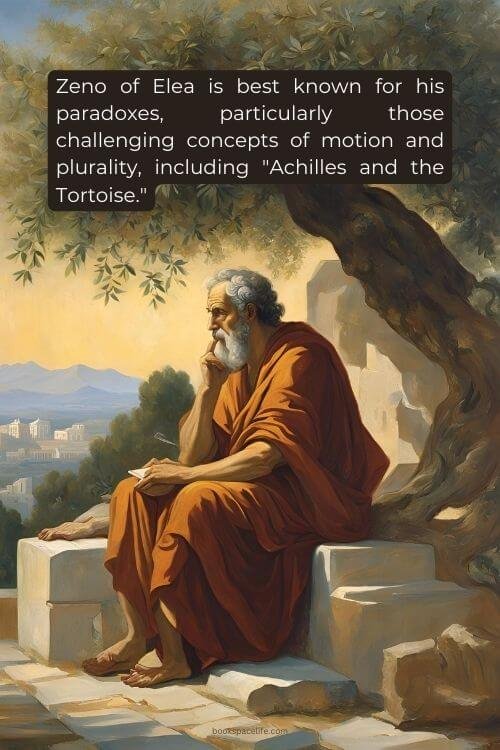
(2) Travels and Philosophical Development
Zeno’s philosophical journey likely included extensive travel within the Greek world, especially to Athens, where he engaged with prominent thinkers and refined his ideas.
He became known as a defender of Parmenides, promoting the idea that the apparent multiplicity of the world is an illusion created by the limitations of human perception.
During his travels, Zeno encountered various philosophical schools and engaged in debates about the nature of reality, knowledge, and the concept of infinity.
These interactions contributed to the development of his paradoxes, which challenged the prevailing views of his contemporaries and laid the groundwork for future philosophical discourse.
(3) Philosophical Contributions
- Zeno’s Paradoxes: Zeno is most famous for his paradoxes, which were designed to illustrate the contradictions inherent in the concept of motion and plurality. His paradoxes can be grouped into several key themes:
- Achilles and the Tortoise: In this paradox, Achilles races a tortoise, giving it a head start. Zeno argues that Achilles can never overtake the tortoise because whenever he reaches the point where the tortoise was, the tortoise has moved ahead. This paradox challenges our understanding of motion and highlights the difficulties in reconciling the concept of continuity with the idea of discrete points in space.
- The Dichotomy Paradox: Zeno argues that before an object can reach its destination, it must first travel half the distance. However, before it can travel half the distance, it must travel a quarter of the distance, and so on. This infinite regression suggests that motion is impossible, as it requires completing an infinite number of tasks.
- The Arrow Paradox: In this paradox, Zeno claims that for an arrow in flight to move, it must change its position at every moment of time. However, if we analyze the arrow’s position at any given instant, it appears to be at rest. Thus, Zeno concludes that motion is an illusion.
- The Stadium Paradox: Zeno presents a scenario involving three rows of objects moving at different speeds. Through his analysis, he reveals apparent contradictions in our understanding of relative motion and speed. This paradox further illustrates the complexities of motion and raises questions about our intuitive understanding of time.
- Defense of Parmenides: Zeno’s paradoxes serve as a defense of Parmenides’ philosophy, which posits that change and multiplicity are illusory. By demonstrating the contradictions in common notions of motion and plurality, Zeno sought to strengthen the argument for a singular, unchanging reality. His work encourages a deeper investigation into the nature of existence and the limitations of human perception.
- Influence on Logic and Mathematics: Zeno’s paradoxes have had a profound impact on the development of logic and mathematics. His exploration of infinite processes and the concept of continuity laid the groundwork for later thinkers, including Aristotle, who grappled with the implications of Zeno’s arguments. Additionally, the paradoxes prompted discussions about the nature of infinity, contributing to the development of calculus in the 17th century.
- Metaphysics and Ontology: Zeno’s work also engages with metaphysical questions about the nature of existence. His paradoxes invite contemplation of the relationship between perception and reality, challenging individuals to consider the implications of their beliefs about the physical world. Zeno’s contributions to metaphysics continue to resonate in contemporary philosophical discussions about the nature of being and the limits of human understanding.
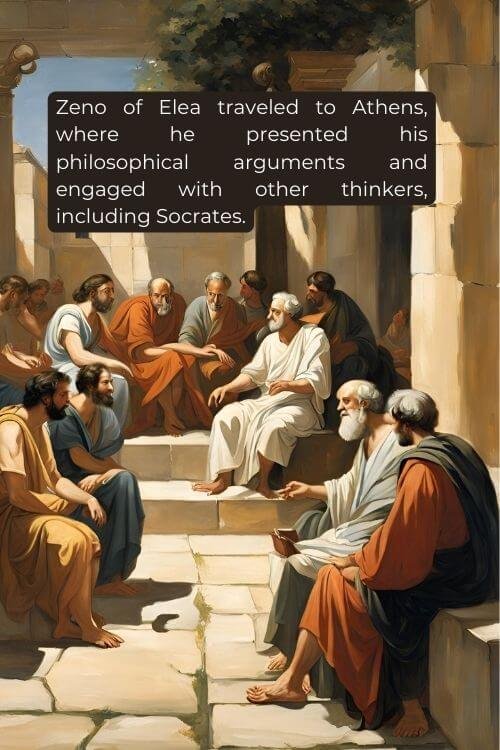
(4) Influence and Impact
Zeno’s ideas and paradoxes have had a lasting influence on philosophy, mathematics, and the sciences, shaping the trajectory of Western thought in several key ways:
- Influence on Plato and Aristotle: Zeno’s paradoxes were critical in shaping the thought of later philosophers, particularly Plato and Aristotle. Plato engaged with Zeno’s ideas in his dialogues, using them to illustrate the complexities of knowledge and reality. Aristotle, in turn, addressed Zeno’s paradoxes directly, attempting to resolve the contradictions they presented. This engagement with Zeno’s work laid the foundation for subsequent philosophical inquiries into motion, time, and the nature of reality.
- Impact on the Development of Mathematics: Zeno’s exploration of infinity and the concept of limits influenced the development of mathematical thought. His paradoxes highlighted the need for a rigorous understanding of continuity and motion, ultimately leading to advancements in calculus and the study of infinitesimals. Mathematicians such as Newton and Leibniz later built upon these ideas, revolutionizing the field and addressing some of the paradoxes Zeno raised.
- Legacy in Philosophy: Zeno’s contributions to philosophy extend beyond the realm of paradoxes. His work prompted deeper inquiries into the nature of knowledge, perception, and reality, influencing later philosophical movements, including Stoicism and Skepticism. The questions Zeno raised about the limits of human understanding continue to resonate in contemporary philosophical discussions, particularly in epistemology and metaphysics.
- Cultural Significance: Zeno’s life and work reflect the rich intellectual culture of ancient Greece, characterized by a quest for knowledge and a willingness to challenge established beliefs. His paradoxes represent a crucial moment in the transition from mythological explanations of the world to rational, systematic inquiries. Zeno’s contributions symbolize the enduring human desire to grapple with the complexities of existence and understand the nature of reality.
- Modern Relevance: Zeno’s paradoxes remain relevant in modern discussions about the nature of space, time, and motion. They continue to provoke thought and debate in various fields, including physics, mathematics, and philosophy. The exploration of motion and the concept of infinity are essential to contemporary scientific inquiry, reflecting the lasting impact of Zeno’s ideas on our understanding of the universe.
(5) Conclusion
Zeno of Elea emerges as a pivotal figure in the history of philosophy, whose innovative ideas and paradoxes have left an indelible mark on Western thought.
Through his exploration of motion, time, and the nature of reality, Zeno challenged conventional beliefs and encouraged a deeper examination of the limits of human perception.
His paradoxes invite us to consider the complexities of existence and the relationship between perception and reality.
Zeno’s work serves as a testament to the power of philosophical inquiry and the importance of engaging critically with our beliefs, inspiring us to explore the mysteries of the universe and our place within it.
As we reflect on Zeno’s life and teachings, we are reminded of the enduring nature of philosophical questions and the complexities of understanding reality.
Zeno’s contributions to logic, mathematics, and metaphysics continue to resonate, inspiring future generations to grapple with the profound questions that shape our understanding of existence.
In an ever-evolving world, Zeno’s legacy endures, inviting us to question, explore, and seek knowledge in the face of life’s paradoxes.
(A) 7 Quick Facts on Zeno of Elea
- Date of Birth – Zeno was born around 490 BCE, during a period of significant philosophical development in ancient Greece.
- Place of Birth – He was born in Elea, a city in southern Italy, known for its philosophical school.
- Education – Zeno was a student of Parmenides, adopting and advancing his teacher’s ideas on being and reality.
- Philosophical Contributions – He is best known for his paradoxes, particularly those challenging concepts of motion and plurality, including “Achilles and the Tortoise.”
- Travel to Athens – Zeno traveled to Athens, where he presented his philosophical arguments and engaged with other thinkers, including Socrates.
- Political Involvement – Zeno was politically active in Elea, reportedly supporting the city’s democratic government against tyrants.
- Legacy – Zeno’s paradoxes laid the groundwork for future philosophical discussions on motion and infinity, influencing later philosophers like Aristotle.
(B) 10 Quotes attributed to Zeno of Elea
- What is not, is not; and what is, is. A foundational statement emphasizing the concept of being.
- There is no such thing as motion. A radical assertion that challenges the perception of movement in reality.
- Achilles can never overtake the tortoise. Illustrating a paradox of motion where the faster Achilles cannot surpass the slower tortoise.
- In a race, the faster must first reach the halfway point. A paradox that highlights the seemingly endless divisions of space in motion.
- If you divide an infinite amount of time into parts, each part is infinitely small. Suggesting that time can be infinitely divided, creating paradoxical implications for motion.
- A body cannot change its position unless it is already in a different position. Questioning the nature of movement and position.
- If there is a plurality of things, then there is also a void. This challenges the notion of a filled universe and the existence of nothingness.
- The line is composed of an infinite number of points. A reflection on the relationship between continuity and discreteness in geometry.
- Things that are infinite cannot be composed of finite things. A philosophical statement about the relationship between the infinite and finite.
- We cannot traverse an infinite series of points. Addressing the implications of infinity in motion and the impossibility of completing such a task.

